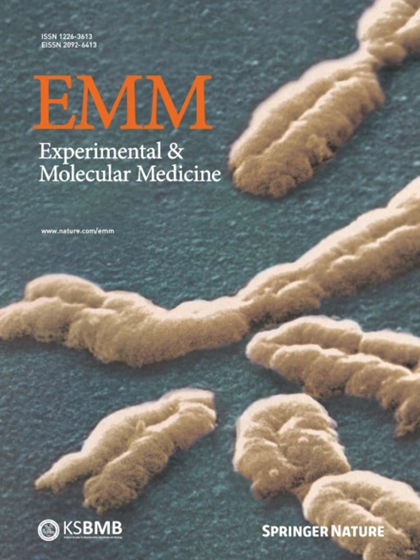蛋白质基因组分析剖析了与预后相关的早期乳腺癌患者。
IF 9.5
2区 医学
Q1 BIOCHEMISTRY & MOLECULAR BIOLOGY
引用次数: 0
摘要
众所周知,早发乳腺癌具有侵袭性临床特征,在东亚国家发病率很高,但人们对其分子特征仍缺乏全面的了解。在这项研究中,我们对韩国年龄小于 40 岁的年轻乳腺癌(YBC)患者的 126 例未经治疗的原发肿瘤组织进行了蛋白质基因组分析。通过整合基因组、转录组和蛋白质组数据,我们确定了五个不同的功能亚组,它们准确地代表了 YBC 患者的临床特征和生物学行为。我们的综合方法可用于确定 HER2 的蛋白基因组状态,从而提高其临床意义和预后价值。此外,我们还提出了一种基于蛋白质组的同源重组缺陷(HRD)分析方法,它有可能克服传统基因组 HRD 检测的局限性,有助于确定需要针对性 HR 缺陷治疗的新患者群体。此外,我们还证明了蛋白质-RNA相关性可用于预测激素受体阳性乳腺癌的晚期复发。在每种乳腺癌分子亚型中,我们都发现了具有重要功能的蛋白质组,其丰度差异与乳腺癌的临床进展密切相关。此外,我们还得出了能够预测晚期复发的复发预测指数,特别是在管腔亚型中,该指数在指导 YBC 患者决定治疗期限方面起着至关重要的作用。这些发现有助于确定最佳辅助治疗方法和疗程,从而改善 YBC 患者的分层和临床疗效。本文章由计算机程序翻译,如有差异,请以英文原文为准。

Proteogenomic analysis dissects early-onset breast cancer patients with prognostic relevance
Early-onset breast cancer is known for its aggressive clinical characteristics and high prevalence in East Asian countries, but a comprehensive understanding of its molecular features is still lacking. In this study, we conducted a proteogenomic analysis of 126 treatment-naïve primary tumor tissues obtained from Korean patients with young breast cancer (YBC) aged ≤40 years. By integrating genomic, transcriptomic, and proteomic data, we identified five distinct functional subgroups that accurately represented the clinical characteristics and biological behaviors of patients with YBC. Our integrated approach could be used to determine the proteogenomic status of HER2, enhancing its clinical significance and prognostic value. Furthermore, we present a proteome-based homologous recombination deficiency (HRD) analysis that has the potential to overcome the limitations of conventional genomic HRD tests, facilitating the identification of new patient groups requiring targeted HR deficiency treatments. Additionally, we demonstrated that protein–RNA correlations can be used to predict the late recurrence of hormone receptor-positive breast cancer. Within each molecular subtype of breast cancer, we identified functionally significant protein groups whose differential abundance was closely correlated with the clinical progression of breast cancer. Furthermore, we derived a recurrence predictive index capable of predicting late recurrence, specifically in luminal subtypes, which plays a crucial role in guiding decisions on treatment durations for YBC patients. These findings improve the stratification and clinical implications for patients with YBC by contributing to the optimal adjuvant treatment and duration for favorable clinical outcomes. Breast cancer is the most common cancer in women globally, with a significant number of young breast cancer (YBC) cases in Korea. YBC is known for its aggressive nature and poor outcomes. This study is aimed to understand the molecular features of YBC in Korean patients using a multiomics approach, which involves analyzing genomic, transcriptomic, and proteomic data from 178 young women with breast cancer. They examined tumor samples and patients’ blood to identify molecular signatures and pathways that could predict clinical outcomes. The team found unique molecular profiles in YBC, including higher mutation rates in certain genes and unique gene expression patterns. They identified several key pathways and potential biomarkers that could predict the cancer’s aggressiveness and the patients’ prognosis. The study revealed differences in the tumor environment and immune response, which could affect treatment strategies. This summary was initially drafted using artificial intelligence, then revised and fact-checked by the author.
求助全文
通过发布文献求助,成功后即可免费获取论文全文。
去求助
来源期刊

Experimental and Molecular Medicine
医学-生化与分子生物学
CiteScore
19.50
自引率
0.80%
发文量
166
审稿时长
3 months
期刊介绍:
Experimental & Molecular Medicine (EMM) stands as Korea's pioneering biochemistry journal, established in 1964 and rejuvenated in 1996 as an Open Access, fully peer-reviewed international journal. Dedicated to advancing translational research and showcasing recent breakthroughs in the biomedical realm, EMM invites submissions encompassing genetic, molecular, and cellular studies of human physiology and diseases. Emphasizing the correlation between experimental and translational research and enhanced clinical benefits, the journal actively encourages contributions employing specific molecular tools. Welcoming studies that bridge basic discoveries with clinical relevance, alongside articles demonstrating clear in vivo significance and novelty, Experimental & Molecular Medicine proudly serves as an open-access, online-only repository of cutting-edge medical research.
 求助内容:
求助内容: 应助结果提醒方式:
应助结果提醒方式:


